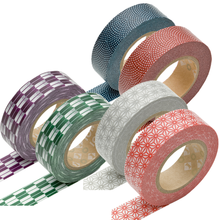Washi
This article has multiple issues.Please helpimprove itor discuss these issues on thetalk page.(Learn how and when to remove these template messages)
|


Washi(Cùng giấy)is traditional Japanesepaperprocessed by hand using fibers from the inner bark of thegampitree, themitsumatashrub (Edgeworthia chrysantha), or thepaper mulberry(kōzo) bush.[1]
Washiis generally tougher than ordinary paper made fromwood pulp,and is used in many traditional arts.Origami,shodō,andukiyo-ewere all produced usingwashi.Washiwas also used to make various everyday goods like clothes, household goods, and toys, as well as vestments and ritual objects forShintopriests and statues ofBuddha.It was even used to makewreathsthat were given to winners in the1998 Winter Paralympics.Washiis also used to repair historically valuable cultural properties, paintings, and books at museums and libraries around the world, such as theLouvreand theVatican Museums,because of its thinness, pliability, durability over 1000 years because of its low impurities, and high workability to remove it cleanly with moisture.[2][3][4]
As aJapanese craft,it is registered as a UNESCOintangible cultural heritage.[5]
History[edit]

By the 7th century, paper had been introduced to Japan from China via the Korean Peninsula, and the Japanese developed washi by improving the method of making paper in theHeian period.The paper making technique developed in Japan around 805 to 809 was callednagashi-suki(Lưu し lộc き),a method of addingmucilageto the process of the conventionaltame-suki(Lưu め lộc き)technique to form a stronger layer of paper fibers.[6][7][8][9]The improved washi came to be used to decorate religious ceremonies such asgohei,ōnusa(ja: Cần sa ( thần đạo )), andshideatShinto shrines,[6]and in the Heian period, washi covered with gold and silver leaf beautifully decorated books such asKokin Wakashu.[8]
In theMuromachi period,washi came to be used asceremonial origamiforsamuraiclass at weddings and when giving gifts,[6]and from theSengoku periodto theEdo period,recreational origamisuch asorizurudeveloped.[10]During the Edo period, many books andukiyo-eprints for the masses made of washi were published usingwoodblock printing.[11]
Manufacture[edit]

Washiis produced in a way similar to that of ordinary paper, but relies heavily on manual methods. It involves a long and intricate process that is often undertaken in the cold weather of winter, as pure, cold running water is essential to the production of washi. Cold inhibitsbacteria,preventing the decomposition of thefibres.Cold also makes the fibres contract, producing a crisp feel to the paper. It is traditionally the winter work of farmers, a task that supplemented a farmer's income.
Paper mulberryis the most commonly used fiber in making Japanese paper. The mulberry branches are boiled and stripped of their outer bark, and then dried. The fibers are then boiled withlyeto remove thestarch,fatandtannin,and then placed in running water to remove the spent lye. The fibers are thenbleached(either with chemicals or naturally, by placing it in a protected area of a stream) and any remaining impurities in the fibers are picked out by hand. The product is laid on a rock or board and beaten.
Wet balls of pulp are mixed in a vat with water and a formation aid to help keep the long fibers spread evenly. This is traditionallyneri,which is amucilaginousmaterial made from the roots of thetororo aoi plant,or PEO,polyethylene oxide.One of two traditional methods of paper making (nagashi-zuki or tame-zuki) is employed. In both methods, pulp is scooped onto a screen and shaken to spread the fibers evenly. Nagashi-zuki (which uses neri in the vat) produces a thinner paper, while tame-zuki (which does not use neri) produces a thicker paper.
Types[edit]
With enough processing, almost any grass or tree can be made into a washi. Gampi, mitsumata, and paper mulberry are three popular sources.[1]
- Ganpishi(Nhạn giấy dai):In ancient times, it was calledHishi(Phỉ giấy).Ganpishi has a smooth, shiny surface and is used for books and crafts.
- Kōzogami(Chử giấy):Kōzogami is made from paper mulberry and is the most widely made type of washi. It has a toughness closer to cloth than to ordinary paper and does not weaken significantly when treated to be water-resistant.
- Mitsumatagami(Tam nha giấy):Made frommitsumata,mitsumatagami has an ivory-colored, fine surface and is used forshodōas well as printing. It has been used to print paper money since theMeiji periodand continues to be used today.[12]
Applications[edit]
Until the early 20th century, the Japanese usedwashiin applications where Western style paper or other materials are currently used. This is partly because washi was the only type of paper available at that time in Japan, but also because the unique characteristics of washi made it a better material.[citation needed]
Washiis also used inwatchdials.[13]
See also[edit]
References[edit]
- ^abHughes, Sukey (1978).Washi: the world of Japanese paper.Tokyo: Kodansha International.ISBN0-87011-318-6.
- ^"Paper conservation by using Japanese paper, washi".International Federation of Library Associations and Institutions.Archived fromthe originalon 9 February 2022.
- ^"The elegant and refined world of washi".Toki. 30 August 2015. Archived fromthe originalon 6 April 2017.
- ^"Washi paper in Mino".ANA. Archived fromthe originalon 5 April 2022.
- ^"Government, paper makers welcome addition of 'washi' to UNESCO list".27 November 2014. Archived fromthe originalon 13 January 2017.Retrieved27 November2014.
- ^abcChiết り giấy の lịch sử と hiện tại: Trước sử(in Japanese).Kyushu UniversityLibrary. Archived fromthe originalon 7 May 2021.Retrieved14 November2022.
- ^おりがみ の lịch sử (History of origami)(in Japanese). Nippon Origami Association. Archived fromthe originalon 14 November 2022.Retrieved14 November2022.
- ^abChương 1 chiết り giấy の tư(PDF)(in Japanese).Nikkan Kogyo Shimbun.Archived fromthe original(PDF)on 25 November 2022.Retrieved25 November2022.
- ^Lưu し lộc き(in Japanese). Kotobank./Digitalio, Inc./The Asahi Shimbun.Archived fromthe originalon 25 November 2022.Retrieved25 November2022.
- ^Chiết り giấy の lịch sử と hiện tại: Chiến quốc ~ giang hộ trung kỳ(in Japanese). Kyushu University Library. Archived fromthe originalon 7 May 2021.Retrieved14 November2022.
- ^"Edo Picture Books and the Edo Period".National Diet Library. Archived fromthe originalon 19 October 2020.Retrieved26 November2022.
- ^https://edition.cnn /2024/07/02/business/japan-yen-note-nepal-paperbush-intl-hnk/index.html
- ^"Review: Enter the dragon: The Citizen AQ 4020-54Y. Best quartz watch in the world?".Deployant.10 May 2018.Retrieved2 September2022.
Further reading[edit]
- Fukushima, Kurio (1991).Handbook on the Art of Washi.All Japan Handmade Washi Association.
